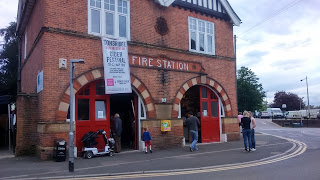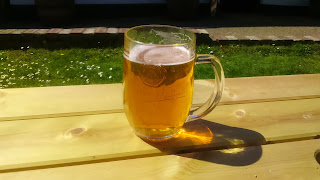 |
| Tonbridge Old Fire Station |
The festival kicked off last Thursday evening, and ran through until late on Sunday afternoon. There were around 40 different ciders and perries on sale; the majority dispensed from either “bag-in-a-box” type containers or the ubiquitous poly-casks. The event was run on similar lines to a CAMRA festival, with tokens in lieu of cash the bar, plus a rather attractive plastic tumbler, with a frosted appearance, which visitors got to keep.
 |
| Poly-casks with internal cooling |
As I was on my bike I limited myself to just a couple of halves, but the second of these weighed in at 7% ABV, and went to my head far quicker than I realised. The ones I tried were Oliver’s Perry 5.5%; a medium-sweet perry from Herefordshire, plus the previously mentioned seven percent job - a medium-sweet cider produced by Gwynty Ddraig in Wales. The latter was served on a stall manned by the well-known gentleman who looks after the cider bar at the Tonbridge Juddian’s beer festivals. He is normally dressed the part, complete with an old farmer’s smock and a straw hat!
 |
| The extensive list of ciders and perries |
One of the main festival organisers was Phil Turner of locally-based Turners Cider. Turners is a family business based in the village of Marden, in the Kent Weald, which makes a range of craft ciders in the "Eastern counties" style. For the uninitiated this is cider made from only dessert and culinary apples, rather than the traditional “bitter-sweet” cider apples, used in traditional West Country cider-making counties, such as Devon, Somerset, Hereford and Worcester plus, of course, Wales.
The comment about people not drinking much did make me laugh though, as how many people can neck more than a few pints of 6-7% ciders and still be left standing? I bumped into three friends from CAMRA who, like myself, “just happened to be passing.” After a catch up on what had been happening, I left them to try a few more ciders and perries. They were on foot, whilst I was on two wheels and I wanted to get home in one piece!
 |
| "Bag-in-a-box" dispense |
It is early days yet, but I imagine the Cider Festival will be repeated, although with perhaps a little less stock. A spokesman for the Old Fire Station, quoted in the local press, said: “The festival just came out of a conversation we had with Phil Turner and it has turned out to be a really popular event. We’ve found that around 90 per cent of people say they are not actually cider drinkers, but this festival has proved that people do like it once they have had the chance to try it.” This bodes well for the future, although next time I will make sure I arrive and leave by shank’s pony rather than on two wheels.
Tonbridge Old Fire Station is a renovated late Victorian building which, as its name suggests, was formerly the town’s fire station. The last fire engine departed back in 1986, when the Fire & Rescue Service moved to a modern and purpose-built facility on the town’s industrial estate, and now, following extensive renovation work, the iconic building has been given a new lease of life as a multi-purpose venue which can be adapted for a range of different purposes. The philosophy behind the Old Fire Station, is to provide space for a variety of pop-up bars, restaurants and shops; thereby giving businesses which are new to the area the opportunity to trade in the town.
The Old Fire Station is tucked away in the streets behind Tonbridge’s imposing 13th Century castle. There is no website for the building, at present, but it does have its own Facebook page.


























